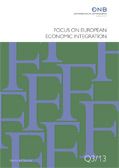Focus on European Economic Integration Q2/21
 OeNB
OeNB
- published:
- June 2021
 OeNB
OeNB
Call for applications: Klaus Liebscher Economic Research Scholarship (PDF, 50 kB) en Jun 8, 2021, 12:00:00 AM
Developments in selected CESEE countries (PDF, 1.2 MB) en Jun 8, 2021, 12:00:00 AM
Outlook for selected CESEE countries and Russia (PDF, 302 kB) en Jun 8, 2021, 12:00:00 AM
What do central banks talk about? A European perspective on central bank communication (PDF, 1.2 MB) Feldkircher, Hofmarcher, Siklos. In this paper, we apply a structural topic model (STM) to analyze over 7,000 speeches delivered by European central bankers and ECB staff over the period from 1996 to 2019. Our findings indicate that neither the size of an economy nor its monetary policy regime appear to be related to how frequently a country’s central bank communicates through speeches with the public. We moreover find that the following four topics dominate in central bank speeches: (1) European integration, (2) monetary policy and price stability, (3) financial stability, and (4) “outside the box” content, subsuming rhetoric on issues beyond central banks’ core responsibilities. While coverage of monetary policy topics has been stable over time, European integration has been discussed less in central bank speeches since the early days of the euro and at least up until the Brexit referendum. Speeches on financial stability surged in the aftermath of the global financial crisis. When examining the regional distribution of topic prevalence, we find that speeches given by central bankers from non-euro area countries broadly follow the trends described above. Interestingly, many speeches delivered by central bank staff from Central, Eastern and Southeastern Europe (CESEE) fall under the “outside the box” category, suggesting that CESEE central banks cover a broader range of topics than the rest of their European counterparts. en communication, central banks, monetary policy, text analysis E52, E58 Jun 8, 2021, 12:00:00 AM
Bank productivity in CESEE countries (PDF, 749 kB) Huljak, Martin, Moccero. This paper looks at the performance of commercial banks in Central, Eastern and Southeastern Europe (CESEE). More specifically, we investigate the productivity growth components and capacity utilization in 11 CESEE EU member states as well as six non-EU countries in the Western Balkans during the period 2011 to 2019. First, we apply the methodology of Kumbhakar et al. (2014) to explain the components of total factor productivity (TFP) growth. Our results suggest that TFP growth is positive in the Western Balkan countries and negative in the CESEE EU member states, largely owing to differences in economies of scale and technical change. When controlling for heterogeneity between banks in these two regions and disentangling permanent and time-varying inefficiency, banks from CESEE Western Balkans countries still appear to be more efficient; the differences are, however, much smaller. Finally, we apply the dual cost approach by Berndt and Fuss (1986) to estimate the capacity utilization of banks. We find that banks in the CESEE EU member states have a lower capacity utilization than banks in the Western Balkans. However, cost-to-income ratios across the two regions are comparable, as Western Balkan banks generate far lower assets per employee and per fixed assets. We also find significant differences between smaller and larger banks in the two regions, with smaller banks apparently catching up with larger ones. Based on these findings we provide some policy recommendations. Overall, given the expected worsening of asset quality due to the COVID-19 pandemic and increasing competition by fintech companies, banks in both Regions need to increase their efforts to move closer to the efficiency frontier. en CESEE region, banking sector, productivity, capacity utilization, panel data C23, D24, G21 Jun 8, 2021, 12:00:00 AM
Statistical annex (PDF, 128 kB) en Jun 8, 2021, 12:00:00 AM